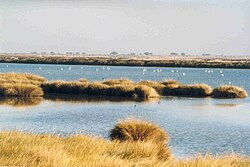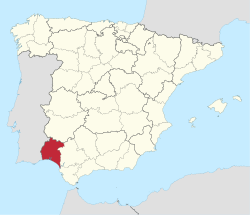Province of Huelva
Huelva | |
|---|---|
 A wetland area ofDoñana National Park | |
 Map of Spain with Huelva highlighted | |
| Coordinates:37°33′N6°55′W/ 37.550°N 6.917°W | |
| Country | Spain |
| Autonomous community | |
| Capital | Huelva |
| Government | |
| • Body | Provincial Deputation of Huelva |
| • President | Ignacio Caraballo (PSOE) |
| Area | |
| • Total | 10,148 km2(3,918 sq mi) |
| • Rank | Ranked 25th |
| Population (2013) | |
| • Total | 483,792 |
| • Rank | Ranked 31st |
| • Density | 48/km2(120/sq mi) |
| Parliament | Cortes Generales |

Huelva(Spanish pronunciation:[ˈwelβa]) is aprovinceof southernSpain,in the western part of theautonomous communityofAndalusia.It is bordered byPortugal,the provinces ofBadajoz,Seville,andCádiz,and the Atlantic Ocean. Its capital isHuelva.
Its area is10,148 km².Its population is 483,792 (2005), of whom about 30% live in the capital, and its population density is 47.67/km². It contains79 municipalities.
The economy is based onagricultureandmining.The famousRio Tintomines have been worked since before 1000 BC, and were the major source of copper for theRoman Empire.As an indication of the scope of ancient mining, sixteen million tons of Roman slag have been identified at the Roman mines. British companies resumed large-scale mining in 1873; the district is the namesake of theRio Tinto Group.[1]
In the 21st century, municipalities such asMoguer,Palos de la Frontera,andLepe,have witnessed the development of intensive water-demanding strawberry farming, which has elicited attention on the basis of alleged mispractices and abuses regarding the labor conditions of foreign workers and the ecocidal depletion of water resources inDoñana.
The province containsPalos de la Frontera,andMoguer,whereChristopher Columbussailed out of on his first voyage in 1492, and shares theParque Nacional de Doñana,located mainly inAlmonte.
Government and administration
[edit]Population
[edit]The historical population is given in the following chart:

Tourism
[edit]The delayed tourist development of the province has allowed better city planning than in other regions on the Spanish coast. The nuclei ofIslantillaandIsla Canelaare an example of this attempt to plan in a more coherent form. Although in a smaller scale in comparison to other regions, urban pressure continues. Previous developments that had little planning until recent time are El Rompido, El Portil, Mazagón and Matalascañas (Torre de la Higuera).
Although Punta Umbría had its beginnings like pedanía de Cartaya, after the democratization of summer tourism, it began its urban development for its proximity to the capital and its location on the beach. Present development would not endure without tourist activity and its vacation housing. Other tourist areas are Nuevo Umbría, Nuevo Portil, Punta del Moral, La Antilla and Urbasur. Themarismas de Isla Cristina,next to the towns ofAyamonteandIsla Cristina,are a protected nature reserve. In the mountain town ofAlmonaster la Real,theVisigothic-mosque churchbuilt in the first decades of the 10th century and whose mihrab is one of the oldest in Spain is one important turistic point.[2]
Of note is Huelva's recent classification of “rural tourism” for its interior mountain range.
Green electricity
[edit]Huelva has 388megawatts(MW) ofwind power,68 MWbiomasspower, and 66 MW ofsolar power.[3]A 220kilovolttransmission linehas been constructed to send power to the main grid as well as improving connections between Spain and Portugal.[4]
See also
[edit]- Cerro Colorado mining deposit
- Chemical Park of Huelva
- List of municipalities in Huelva
- Labour inspectorate
- Port of Isla Cristina
- Tharsis-La Zarza mining basin
References
[edit]- ^Famous mineral localities: The Rio Tinto mines, Huelva, Spain | Mineralogical Record | Find Articles at BNET
- ^Jiménez Martín, Alfonso (1998)."La Mezquita de Almonaster la Real".Archived fromthe originalon 6 August 2008.Retrieved4 June2008.
- ^"The province generates 533 megawatts of electricity from renewable energy".EuropaPress,10 June 2012. Retrieved: 16 June 2012.
- ^"Iberdrola Renewables starts up the largest wind power facility in Spain".EuropaPress,11 February 2010. Retrieved: 16 June 2012.
External links
[edit]- Official website(in Spanish)
- Natural Park Doñana(in Spanish)
- Natural Park Sierra de Aracena and Picos de Aroche(in Spanish)
- Mine & mineral localities in HuelvaatMindat.org


